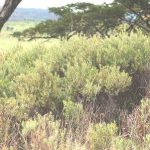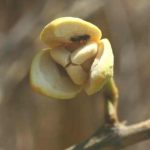TREE LIFE
JUNE 1980
MASHONALAND CALENDAR
Saturday 7th June : Botanic Garden Walk, 1100 hours. Meet in the car park at 1045 hours. As in past years, the winter months Botanic Garden walks will be held on the first Saturday morning of the month. I overlooked this when compiling the May Newsletter and feel that in view of the cold and poor evening light, we must change to the Saturday. Apologies to those who have already made other plans for that day.
Sunday 15th June : Hallam Dam Visit. Unfortunately no bus is available this month. Meet to share transport at 0900 hours at Eastlea Shopping Centre (opposite the Market on the Umtali Road). Those wanting to spend the morning and afternoon, bring lunch baskets.
PREHISTORY SOCIETY MEETING : Wednesday June 18th : Queen Victoria Museum, 2000 hours. Mr. Stephen Mavi from the National Herbarium will be speaking on the topic of “Useful Plants”. Tree Society members will be most welcome.
BOTANIC GARDEN WALK : Tuesday 6th May
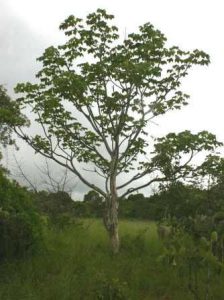
Sterculia quinqueloba . Photo: Bart Wursten. Source: Flora of Zimbabwe
Once again, members elected to look at lowveld species we may find at Umniati.
Excoecaria bussei was most distinctive, being in full fruit. These are the typical 3-part euphorbiaceous type, and the sap the usual milky latex of the family. Sterculia quinqueloba was also fruiting, the green pods giving off a sticky, aromatic resin. Combretums we can expect to see in abundance and Tom Muller points of identification Combretum zeyheri, C. apiculatum, C. elaeagnoides and C. imberbe.
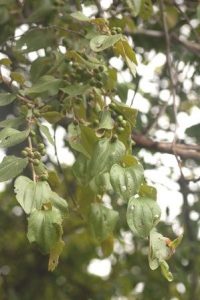
Ziziphus abyssinica . Photo: Bart Wursten. Source: Flora of Zimbabwe
Ziziphus abyssinica was fruiting profusely, apparently a highly intoxicating drink can be prepared from this fruit, which in any case, makes pleasant, if rather dry, eating when ripe.
The mopane, Colophospermum mopane, is of course, very common at Umniati, but we digressed during the walk to examine the two “false mopane” species, Guibourtia coleosperma and G. conjugata. Though the leaves are superficially similar to mopane, the venation is quite different. The main veins of the mopane leaf fan out from the base of the leaf, whereas the false mopanes have the more usual single min vein (midrib), branching out some way from the leaf base. G. conjugata occurs on Karroo sands only, and has a yellowish bark. G. coleosperma occurs on Kalahari sands, and tends to have a liver coloured bark.
MAKABUSI WOODLANDS ASSOCIATION
Good news is that the lease with the Municipality is ready for signature and members should look for details in the national press. An open day will be held by the MWA on Sunday 29th June 1980 and again details will be given in the press. In view of continual Tree Society involvement with this very worthwhile project over a long period of years we hope that there will be a good turnout of our members at this open day.
Members will recall that the Tree Society committed a sum of $250 from our reserves as our contribution to the woodlands project, once the lease has been signed. We will pay this amount over to the MWA together with what else we are able to collect from our membership, and in terms of our resolution in 1976 we hope to raise a further $250 and therefore make a total contribution of $500. Again I would like to remind our members that this financial contribution to the woodlands project is in fact our society’s memorial to the late Douglas Aylen who worked so hard to preserve the woodlands and who, I am emphatic to say, was very largely responsible for the ground work in years past which has led today to the Makabusi Woodlands Association. In saying this I do not wish to belittle the sterling efforts of all others who worked in harness with Douglas, but Douglas was our man, and this contribution by our Society will be our memorial to Douglas, and this will in fact make the whole of the woodlands project a living memorial to our collective fond memories of Douglas and the great man he was.
Members and others who would like to contribute in this respect should please send their contributions to the Tree Society Treasurer at Box 2128, Marked D. Aylen Memorial Fund for the Makabusi Woodlands project.
EPWORTH BALANCING ROCKS
I have received the following communication from the Secretary of the National Trust : “I have been instructed to advise you that admission charges of 25c per adult and 10c per child will operate for admission to the Epworth Balancing Rocks with effect from 16th April, 1980. The only persons who will be admitted free of charge are members of the Trust who must display their membership card and people who are to be known as the “Friends of Epworth Balancing Rocks”. They will be individuals who have personally and physically contributed to the work of developing the site in the period ending 30th June 1981 and who will be issued with the appropriate badge.
I have been instructed to request your organisation to submit a list of your members who have undertaken work in the development of the Epworth Balancing Rocks up to this date and to advise me of any persons who qualify for this badge between now and the 30th June 1981.”
We know that Mr Colin Williams and Mr. Tom Muller amongst our membership will qualify as above, there may be others of our members who have been hiding their proverbial light, and do in fact qualify as above, if so please write to the Tree Society Secretary and we will put your name forward.
BLEEDING MSASA TREES
A member in Sinoia writes to say that the three beautiful musasas in her garden are ‘bleeding’ gum and have done so for some time, she asks if we can explain why this happens, and what causes it. One branch has been cut off after it died and was found full of worms, whether they came before the limb died or after was not evident, and are these ‘worms’ connected with the production of the red gum??
This musasa ‘bleeding’ is commonly seen, can anyone give us answers to these questions?
“BRANCHING” OUT: The Society has recently been pleased to welcome several competent ‘birders’ to its ranks, and, of course we have had a good sprinkling of such avian oriented tree types for many years. The two interests go very much in hand, and as the exasperated spouse of one committee member puts it “The trees are for the birds and the birds are for the trees”. A spark of wisdom though I doubt it was intended as such.
With this in mind, it is intended to include interesting sightings of birds in our entries for “Science News” , so if any members have interesting observations from our outings, please speak up, or write in to Box 2128.
In addition, we may be able to assist in a Survey being carried out by the Ornithological Society of Zimbabwe, into the status and breeding of six species of bird namely a) Bateleur Eagle b) Black Stork c) Crowned Crane d) Wattled Crane e) Kori Bustard and f) Grass Owl.
Any sightings of these birds from any locality would be appreciated by the Survey Organiser, please write to Cheryl Haxen, Zoology Department, UZ, P.O.Box MP 167, Mount Pleasant.
Survey cards and information will be sent to anyone interested in contributing.
AND PRESSING MATTERS – some while back an article dealing with collection of plant specimens appeared in the Newsletter. Meg and Paul Coates Palgrave have since come forward to reveal a somewhat unorthodox method, by which, however, they have obtained some of their best pressed specimens. Being short of time and space on one occasion the specimens were hastily put between newspaper sheets and placed under the mattress of their caravan bed. And, some days later, out came the perfect specimens. Quite handy for travelers who don’t want cumbersome presses cluttering up the place. Of course, this method should only be employed with solid base beds, the spring type would tend to break or bend the specimens. It is recommended that the newspaper is changed every two days in humid weather.
WEEKEND AT UMNIATI : 17TH 18TH MAY 1980
Meg Coates Palgrave has made a comprehensive list of species, 62 in all, recorded on this trip and has provided the following notes :
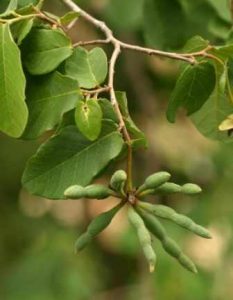
Friesodielsia obovata . Photo:Bart Wursten. Source: Flora of Zimbabwe
Apart from all the other memories we will have of that wonderful weekend, tree wise, I am sure it will be remembered for the Friesodielsia obovata in full fruit near the river. The fruit, correctly called monocarps, restricted between the seeds, might more happily be described as bunches of miniature strings of red sausages.
Unfamiliar combretums were also a feature of the trip; the majestic Combretum imberbe with its grey leaves and distinctive trunk; Combretum zeyheri, unmistakable with its large fruit, but showing leaves in whorls of 3, a feature we usually associate with C. fragrans. The latter we saw in autumn colour, on the journey down. C. hereroense, the very variable ‘mouse ear’ combretum, was distinctive when seen in fruit with its velvety brown, golden winged pods. I was thrilled to find about 40 within reach. One of these had 5 wings, and one six wings. All the books described the pod as 4 winged, so I wonder if this was in fact an exceptional tree, or is having more than 4 wings more common than is generally reported. Something to bear in mind for our future observations. All pods were opened to extract the seed, and all but 8 contained little grey grubs.
Combretum apiculatum showed the distinctive feature of point-tipped leaves, but were not as elongated and twisted as expected. What I thought was C. obovatum was in fact C. mossambicense fulfilling all its expected locality criteria – long trailing branches, and growing on an anthill on the outer fringe of riverine thicket. Also, coming down to the river was C. erythrophyllum, with its very small pods.
Dominant along the river was the river Rhus, Rhus quartiniana. The seed of this species are very small, and probably water distributed, as many branches overhung the river.
Ficus capreifolia, the riverine sandpaper fig, was another new friend. The very coarse leaves are reputed to be used as sandpaper, and, while they are certainly rough enough, they would have to be used very fresh. The specimen I collected as dry and brittle within 30 minutes.
Grewia schinzii in the riverine fringe was another new specimen. This species bears twin berries joined loosely at the base.
Acacias are often confusing and we found several. Acacia fleckii was the most common, and here grew to good sized trees, not only thicket as in other parts of the country. We were also introduced to A. goetzei, very like A. nigrescens in appearance but differing from this by the more numerous leaflets.
Strychnos potatorum and S. innocua, both in fruit were seen together in the riverine. These, together with Erythroxylum zambesiacum and a baobab (without the skirt of crochet work of the Gatooma specimen) were some of the highlights.
On a visit to the Euphorbia cooperi kopje, on the map termed “Small dolorite dyke” we found the lavender croton, Croton gratissimus, and earlier near the river we had seen Croton megalobotrys. G. gratissimus is strongly aromatic, and it is said, was favoured as a perfume in the ‘old days’. However, being a valued perfume, only the wives of chiefs, or other royalty were permitted to use it. Any lesser mortals found using the reserved scent were put to death!
Also on the dyke was Elephantorrhiza goetzei subsp lata. This subspecies has larger leaflets than the type we were used to.
In addition to the above, species of interest included the palm Hyphaene ventricosa, two Hippocratea species, H. longipetiolata and H. parvifolia and Mimusops.
Mrs. G. Masterson studied more than trees and collected several herbs and wild flowers for identification. One of these Lepidagathis scarosa proved exciting, being only the second record in Central Africa of its occurrence. She also added a further 10 species to the list.
A brief tour of the Umniati Power Station was arranged for interested members. And, in fact, this visit was not as out of place for members of an outdoor society as it may seem. Umniati is a thermal power station, and it was rather sobering to realize the bulk of coal (itself the remains of vegetation) which is burnt to supply essential power. This of course brings us to consider the present controversy surrounding the flooding of the Mana Pools area, and to ask ourselves whether the loss of this unique area is not balanced by the damage to the environment inflicted by alternate means of generating power.
Sincere thanks to those who made all the arrangements for a most enjoyable weekend, and to all those at Umniati who fed and housed us.
MATABELELAND CALENDAR
Sunday June 1st : Visit to the New Game Park, Tshabalala. Meet 0830 hours at Retreat Shopping Centre. We will be compiling a tree list for the area.
Sunday July 6th : Visit to an area of Kalahari Sand vegetation not far from the city. Meet at City Hall car park at 0830 hours.
GEORGE HALL CHAIRMAN


